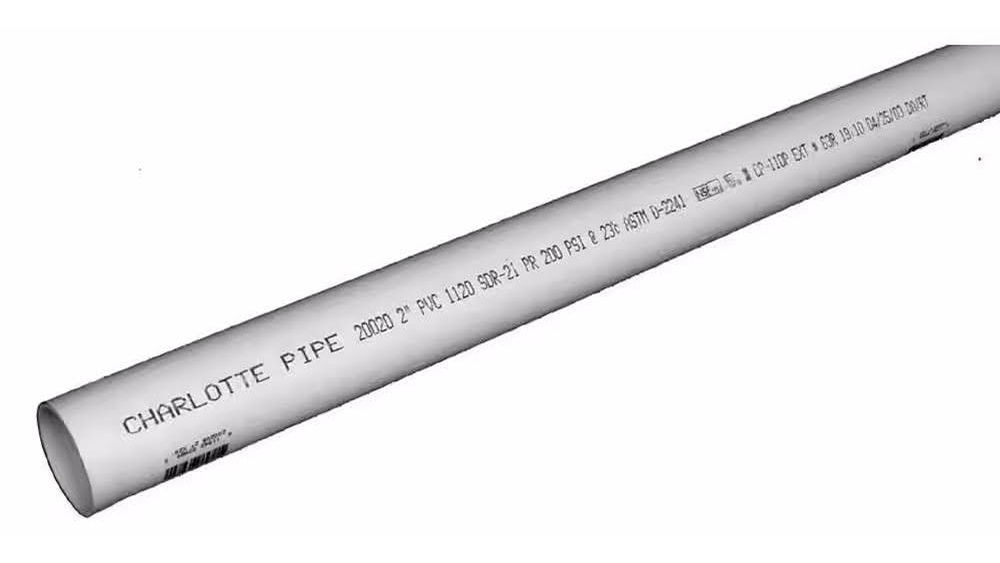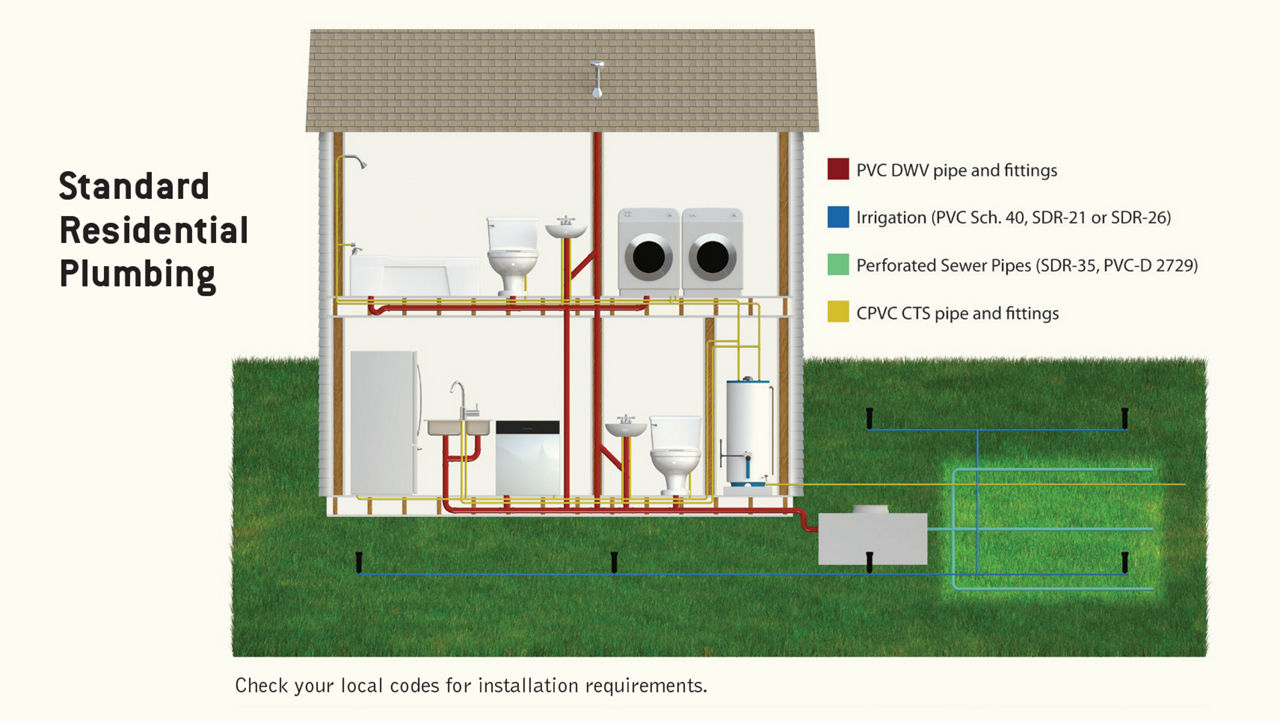
- Common Pipe Sizes and What Each Size is Typically Used For
- Pipe Sizing by Type: Nominal vs Actual Dimensions
- How to Figure Out Pipe Size from Markings
- What Pipe Size Should I Use for Common Projects?
Common Pipe Sizes and What Each Size is Typically Used For
Using the wrong size can lead to reduced water pressure, drainage issues, or even system failures. Whether you’re replacing a drain line or installing new water supply lines, here’s a breakdown of the most common plastic pipe sizes and what they’re typically used for in residential and light commercial projects.
| Pipe SizeTypical UseApprox. Flow Rate, GPM = Gallons Per Minute1/2 inchBathroom sink faucets, toilet supply lines, ice makers, dishwashers7-9 GPM3/4 inchWashing machines, outdoor spigots, bathtubs, showers10-14 GPM1 inchMain cold and hot water supply lines18-22 GPM1.5 inchKitchen sinks, laundry drains, vent systems30-40 GPM2 inchUtility sinks, washing machine drains, floor drains, vent stacks50-60 GPM3 inchToilet drains, shower bases, bathroom branch lines75-100 GPM4 inchMain sewer lines, whole-house drainage, outdoor drains150-180 GPMWhy Choose ItIdeal for low-flow fixtures; affordable and easy to install. Available in PVC, CPVC, and PEX.Higher flow rate than 1/2″; great for medium-demand water lines.Ensures strong pressure and volume throughout the home; perfect for main water feeds.Common for drain lines with moderate flow. Easily connects to P-traps and standard fittings.Handles high drainage volume. Often required by code for laundry areas.Standard for waste lines; large enough for solids, reducing clog risk.Maximum drainage capacity. Used for main lines to sewers or septic tanks. |
Pipe Sizing by Type: Nominal vs Actual Dimensions
PVC Pipe Size Chart (Schedule 40)
PVC pipe uses nominal ID sizing, but OD is what you’ll actually measure with a ruler or calipers. The wall thickness (affecting ID) increases with schedule (Sch 80 = thicker walls, smaller ID).
| Nominal Size1/2″3/4″1″OD (inches)0.840″1.050″1.315″ID (inches)0.622″0.824″1.049″NotesMost common for bathroom fixturesGood for outdoor spigots, showersMain water lines1-1/4″1-1/2″2″1.660″1.900″2.375″1.380″1.610″2.047″Higher flow linesDrainage and vent pipesUtility sinks, large drains |
PVC Pipe Size Chart (Schedule 80)
| Nominal Size1/2″3/4″1″Outer Diameter (OD)0.840″1.050″1.315″Inner Diameter (ID)0.546″0.742″0.957″NotesThicker wall; stronger for pressure useSlightly less flow capacity than Sch 40Suitable for higher-pressure systems1-1/4″1-1/2″2″1.660″1.900″2.375″1.278″1.500″1.939″Often used in irrigation and industrial systemsReduced flow compared to Sch 40 at same ODGreat for systems needing durability + pressure resistance |
- OD is identical between Schedule 40 and Schedule 80 for a given nominal size.
- ID is smaller in Schedule 80 due to thicker walls → lower flow rate.
- Pressure rating is higher in Schedule 80, making it ideal for industrial, commercial, or high-pressure plumbing systems.
CPVC Pipe Size Chart
| Nominal Size1/2″3/4″1″OD (inches)0.625″0.875″1.125″ID (approx.)0.485″0.685″0.895″NotesMatches 1/2″ copperMatches 3/4″ copperGood for hot/cold main lines1-1/4″1-1/2″2″1.375″1.625″2.125″~1.05″~1.26″~1.59″Less common in residentialLarger systems or commercial useUsed for high-volume hot water |
CPVC pipe follows Copper Tube Sizing (CTS), so OD is smaller than same-named PVC. Not interchangeable with PVC fittings.
PEX Pipe Size Chart
| Nominal Size1/2″3/4″1″OD (inches)0.625″0.875″1.125″ID (approx.)0.475″0.681″0.875″NotesFlexible and perfect for small linesCommon for bathroom or kitchenMain supply lines1-1/4″1-1/2″2″1.375″1.625″2.125″1.054″1.246″1.613″Less common; high-volume zonesTypically for commercial useLarge-scale or multi-family installations |
PEX pipe sizing matches CPVC/Copper (CTS) – but PEX is more flexible, and has thinner walls, so you get more internal flow at the same OD.
How to Figure Out Pipe Size from Markings
When you’re trying to identify or replace a plastic pipe, one of the easiest ways to determine its size is by reading the markings printed directly on the pipe. These markings can tell you the nominal diameter, material type, pressure rating, and specs, which all affect what fittings or replacement pipes you’ll need.
Here are the key parts of a typical pipe marking that relate to sizing:
- Nominal Size – The labeled pipe size (e.g. 1/2″, 2″). This helps you match to standard fittings – but it may not match the actual physical measurement.
- Material Type (PVC, CPVC, PEX) – Different materials follow different sizing systems. For example, PVC uses IPS (Iron Pipe Size), while CPVC and PEX often use CTS (Copper Tube Size).
- SDR or Schedule – Affects wall thickness, and therefore the inner diameter (ID) of the pipe, even when the nominal size is the same.
- ASTM Standard – Tells you what sizing system and application the pipe follows (e.g. ASTM D2241 = SDR pressure pipe, ASTM D1785 = Schedule 40/80 PVC).
Real Example: Charlotte Pipe Marking

Let’s decode this actual pipe marking:
Charlotte Pipe 20020 2″ PVC 1120 SDR-21 PR 200 PSI @ 23°C ASTM D2241
Here’s what it tells you about the pipe and it’s size:
- Charlotte Pipe: The manufacturer (find Charlotte Pipe products)
- 20020: Internal product/catalog number for a specific 2″ SDR-21 pressure pipe
- 2″: Nominal pipe size
- PVC 1120: Material type – PVC made from 1120 resin, which meets specific strength and durability requirements
- SDR-21: Standard Dimension Ratio – defines wall thickness relative to pipe diameter
- PR 200 PSI @ 23°C: Pressure Rating – safe for 200 PSI at 23°C (73.4°F). Must be derated at higher temps.
- ASTM D2241: Complies with the ASTM standard for SDR-rated pressure pipes
How to Measure Pipe Size When Markings Are Missing
If the markings on a pipe are faded, painted over, or completely gone, you can still figure out the size with a simple measurement. Use calipers or tape measure to measure the outside diameter (OD) of the pipe. Then, compare that number to a standard size chart for the pipe’s material (PVC, CPVC, or PEX). Keep in mind that the nominal size doesn’t match the OD exactly. For example, a 1-inch PVC pipe actually has an OD of 1.315 inches.
What Pipe Size Should I Use for Common Projects?
Choosing the right pipe size depends on what you’re trying to do. Using a pipe that’s too small can restrict flow or cause backups, while using one that’s too large might be overkill – or simply not fit your existing setup. Here’s a quick reference for recommended pipe sizes based on common household and light commercial plumbing projects:
| Project / Fixture | Recommended Pipe Size | Notes |
| Bathroom sink supply line | 1/2″ | Use PEX, CPVC, or PVC with correct adapter |
| Toilet supply line | 1/2″ | Standard for most homes |
| Shower or tub supply line | 1/2″ or 3/4″ | Use 3/4″ for better pressure with multiple outlets |
| Kitchen sink supply line | 1/2″ | Often fed by 1/2″ PEX or CPVC |
| Washing machine water supply | 3/4″ | High-flow fixture needs wider diameter |
| Dishwasher supply line | 3/8″ or 1/2″ | Usually a flexible braided line connected to 1/2″ |
| Ice maker / refrigerator line | 1/4″ or 3/8″ | Low-flow line – PEX or copper tubing common |
| Outdoor spigot / hose bib | 3/4″ | Ensures good water pressure for hoses |
| Main water service line (to house) | 1″ or 1-1/4″ | Depends on home size and number of fixtures |
| Kitchen sink drain line | 1-1/2″ or 2″ | 2″ preferred if connecting multiple drains |
| Shower or bathtub drain | 2″ | Required by code in most areas |
| Washing machine drain | 2″ | Handles high-volume discharge |
| Toilet waste line | 3″ | Required minimum for solids |
| Main drain or sewer line | 4″ | For whole-home drainage or sewer lateral |
